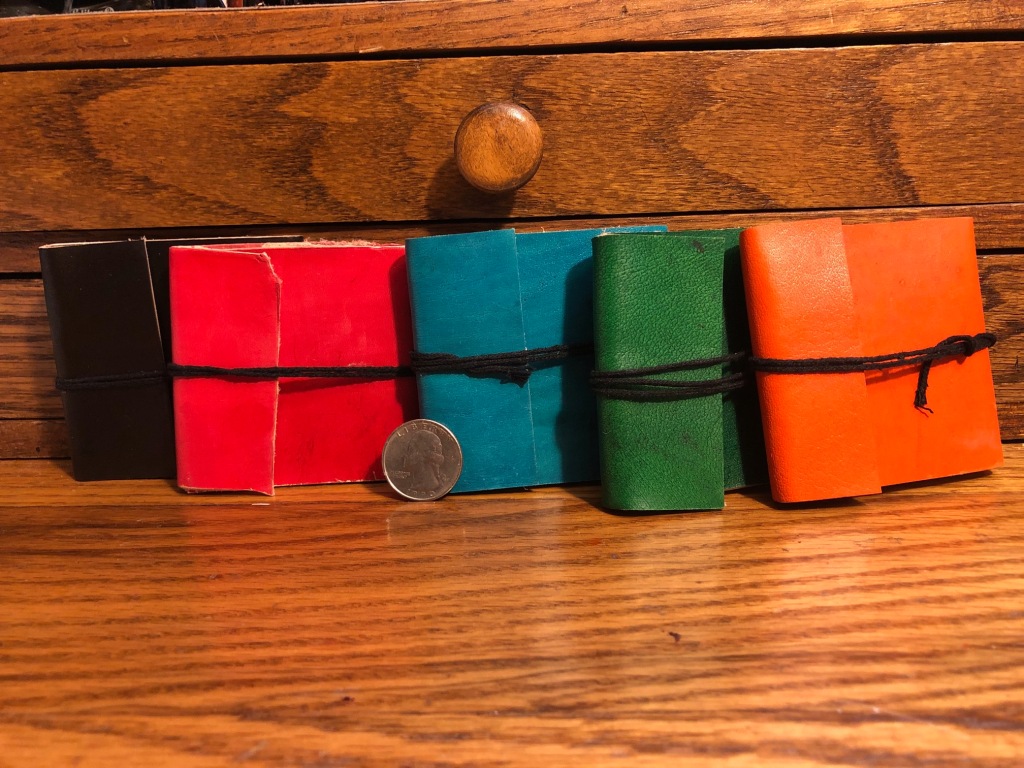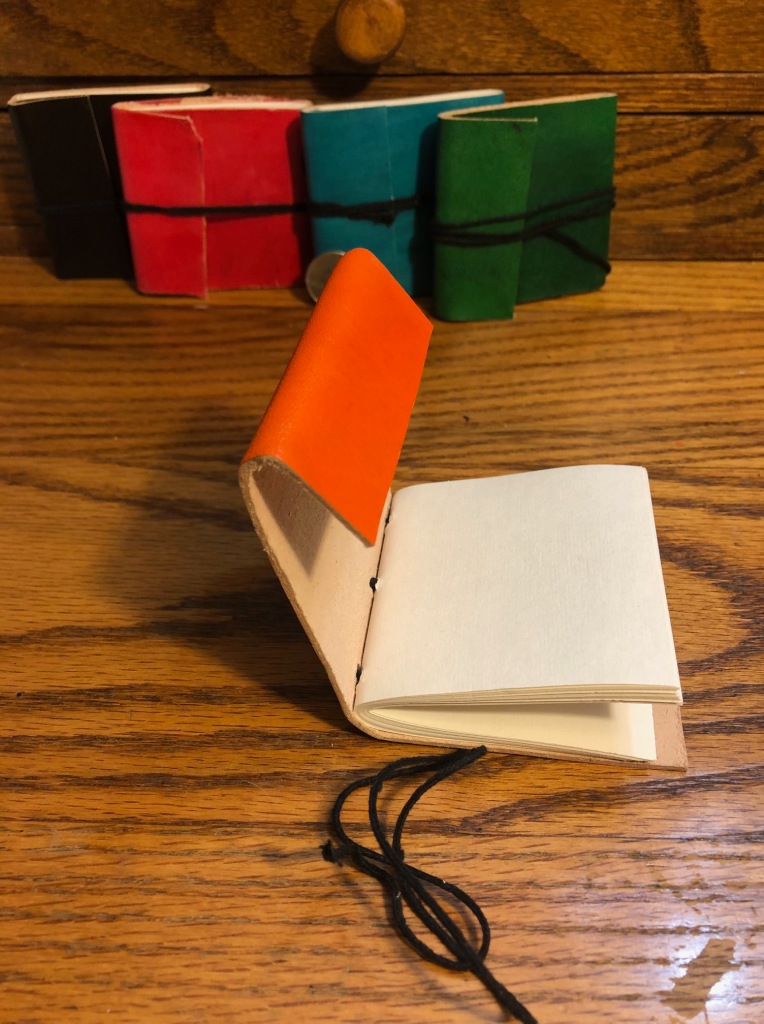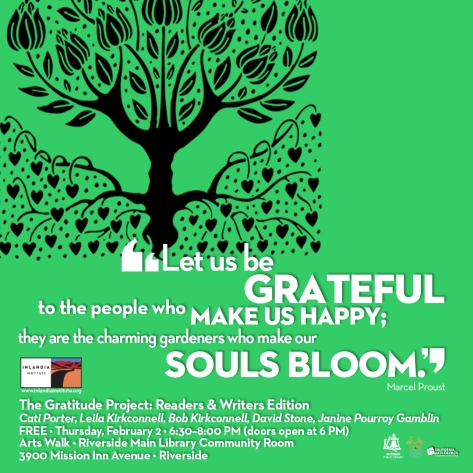
Gratitude Postcards
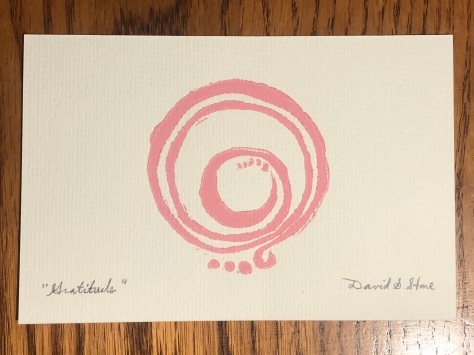
I carved a block with the international gratitude symbol and printed it in pink, a color associated with gratitude. I want to provide guests at the upcoming Riverside Arts Walk who attend Inlandia’s panel discussion at the library an opportunity to express their gratitude to a writer through a postcard.
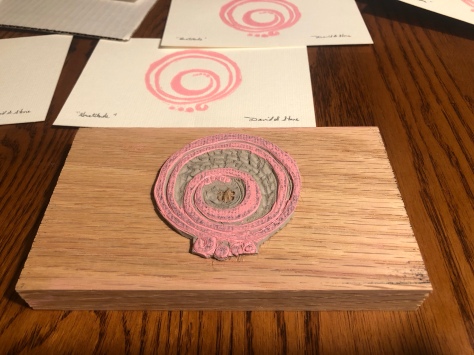
Thursday, February 2, 2023
First Thursdays Arts Walk
“The Gratitude Project: Readers & Writers Edition”
with Janine Pourroy Gamblin, Cati Porter, Leila Kirkconnell, Robert Kirkconnell, and David Stone
Riverside Main Library
3900 Mission Inn Blvd
Riverside, CA 92501
Doors Open at 6:00 PM
6:30-8:00 PM
Free and open to the public.
Is gratitude part of what it takes to build a writer’s life? We think so.
In reading and writing, as in life, we don’t often take the time to tell people how much they – and their work – mean to us. Join Inlandia and a gathering of IE writers to learn how to weave together a literary life, and discover ways readers and writers can express gratitude for one another while doing so.
First Haiku of 2023
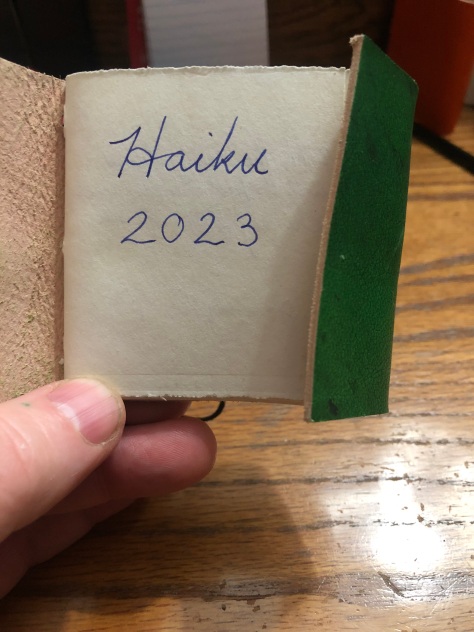
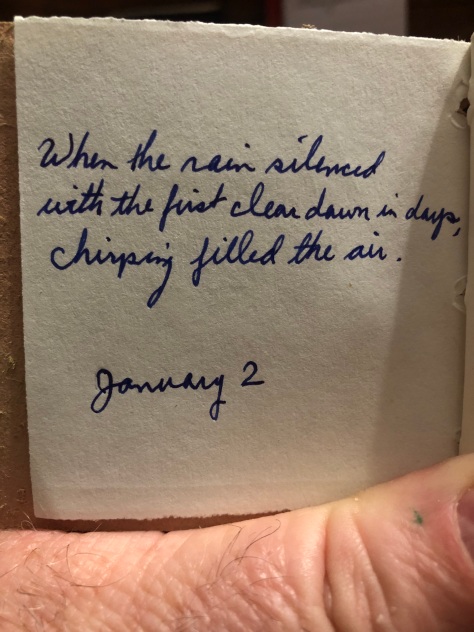
Mini Journals for My Birthday
Rhetorical Terms for Sentence Structures
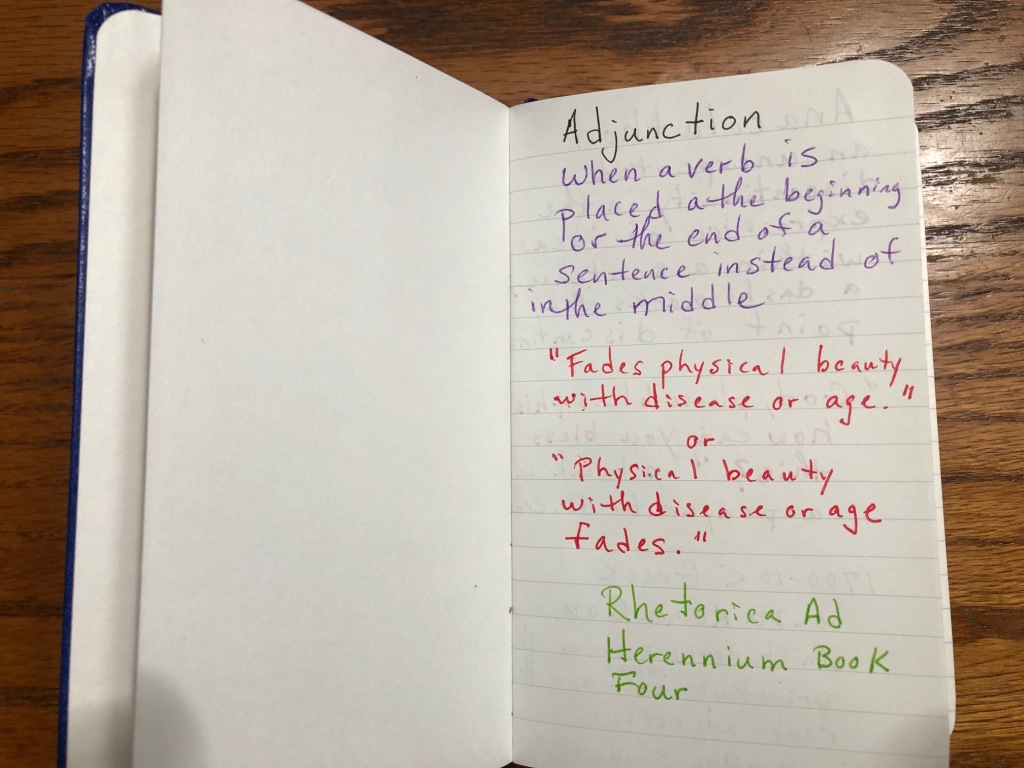
I may be going a bit nerdy, but this is my first entry in my sentence journal focused on classical rhetorical devices.
I decided to research rhetorical terms that relate to sentence structures and collect them in my sentence journal for this year. I’m starting with a Glossary of Rhetorical Terms on Wikipedia. I’m only selecting the terms that relate to sentence structure to include in this journal. I’m color coding the term (black), definition (purple), example (red), and source/origin (green).
Having taken a graduate course in composition and rhetoric, a couple of years of Greek, and a short course in Latin, I have just enough knowledge to make this approach work for me. As an English teacher, I already know my basic grammar fairly well.
I enjoy thinking about sentences as patterns.
I’ve ordered an English translation of Rhetorica Ad Herennium which has been traditionally attributed to Cicero, but whose author is now considered unknown. I’m hoping it will help with this project.
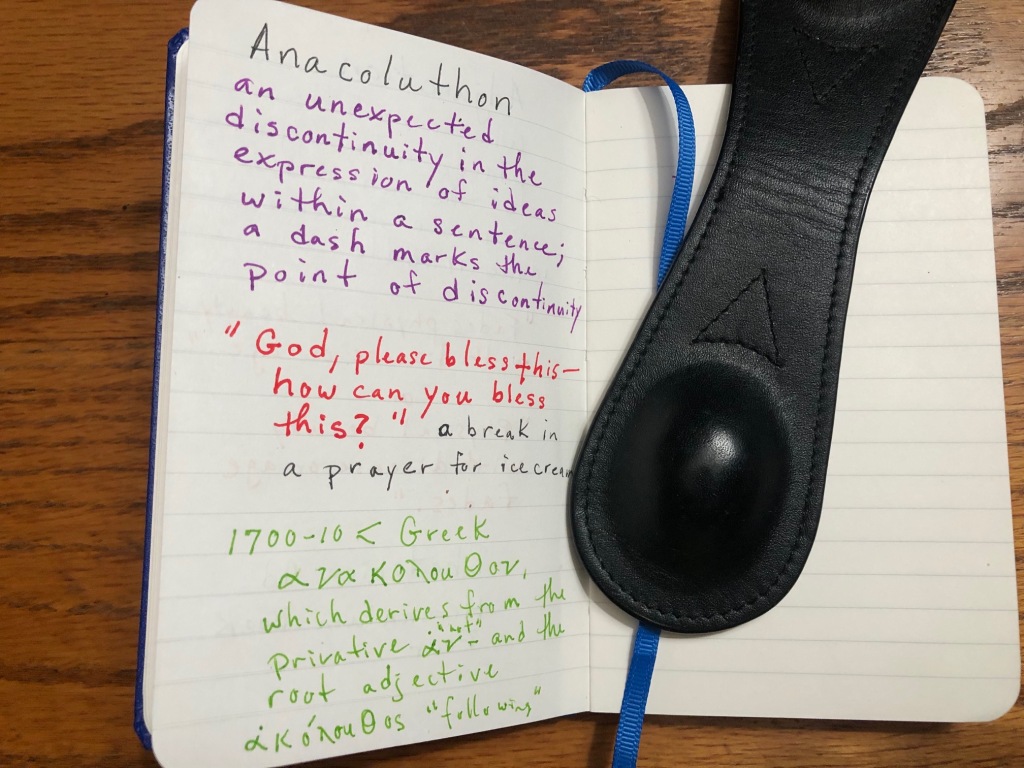
My example came from a humorous moment in high school when I stopped mid grace over an ice cream cone.
Inlandia Literary Journeys Column
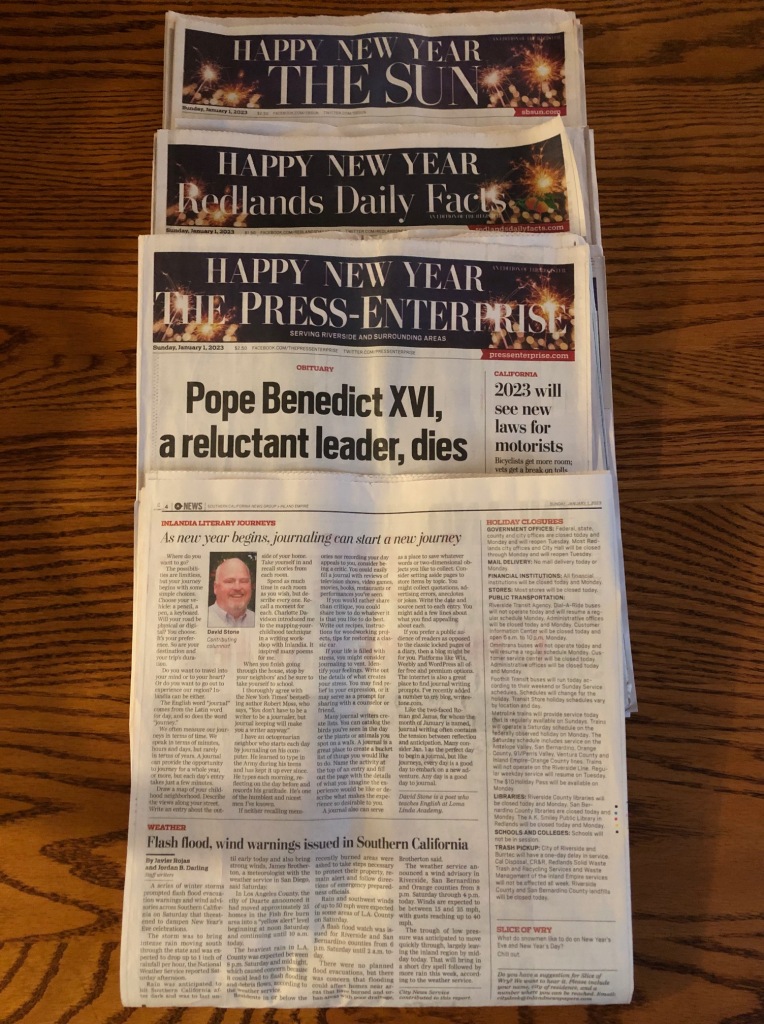
I wrote thirty-one ideas for journaling over the past month in preparation for this column’s publication. I still have more ideas that I will share later, but my streak of posts on journaling ideas will cease for now.
Today I have to make some tough decisions about which of those ideas I will actively pursue for myself this year.
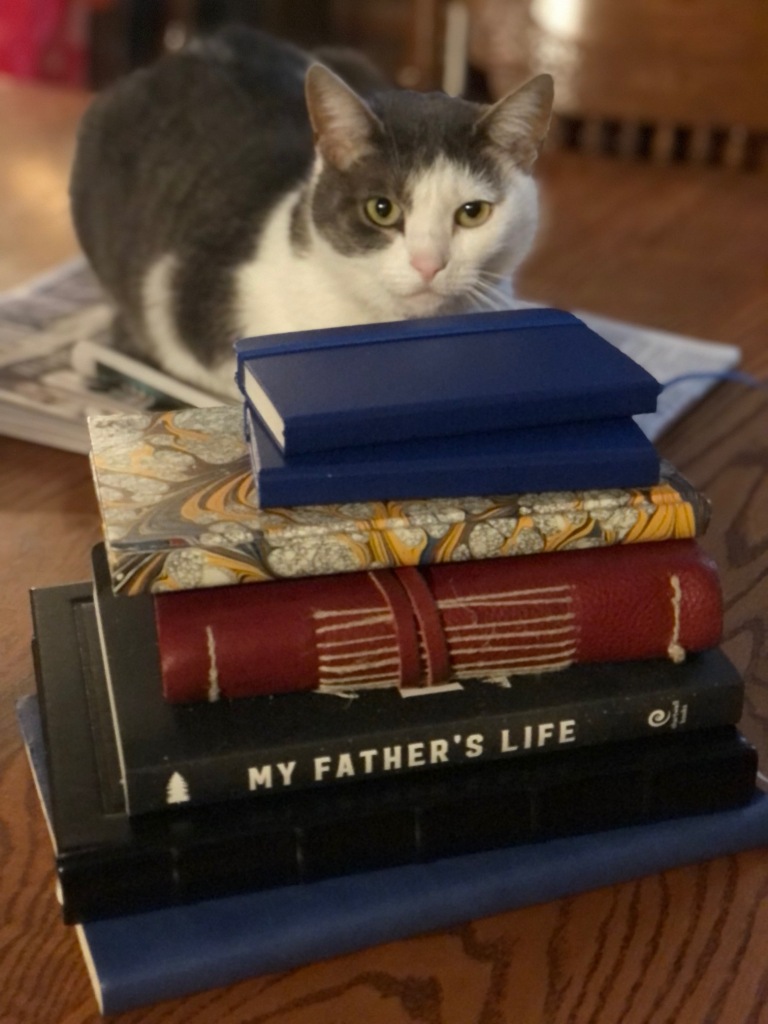
I’m going to continue occasionally to record memories of my parents in my grief turned relishing journals (blue for my mom and red for my dad). I will continue to use my black gratitude journal. I’m going to write in response to the pre-written prompts in My Father’s Life journal that my son gave me at least once a week. I’m going to start a nursery rhyme journal in the marble covered book that I have repurposed by slicing out the few pages I had started in it twenty-five years ago. I’m going to use one of the blue mini journals I got from my wife for a sentence journal and the other for my Title My Day journal. I’m going to keep going with my encourager’s journal online. I’d like to keep up with the comic journal that I started, but only occasionally.
Although I am chiding myself about only having so much time, I just overheard my wife talking to her mother about some other new journals that she has bought me for my birthday, so will see what happens.
Journaling Idea #31: The Classic
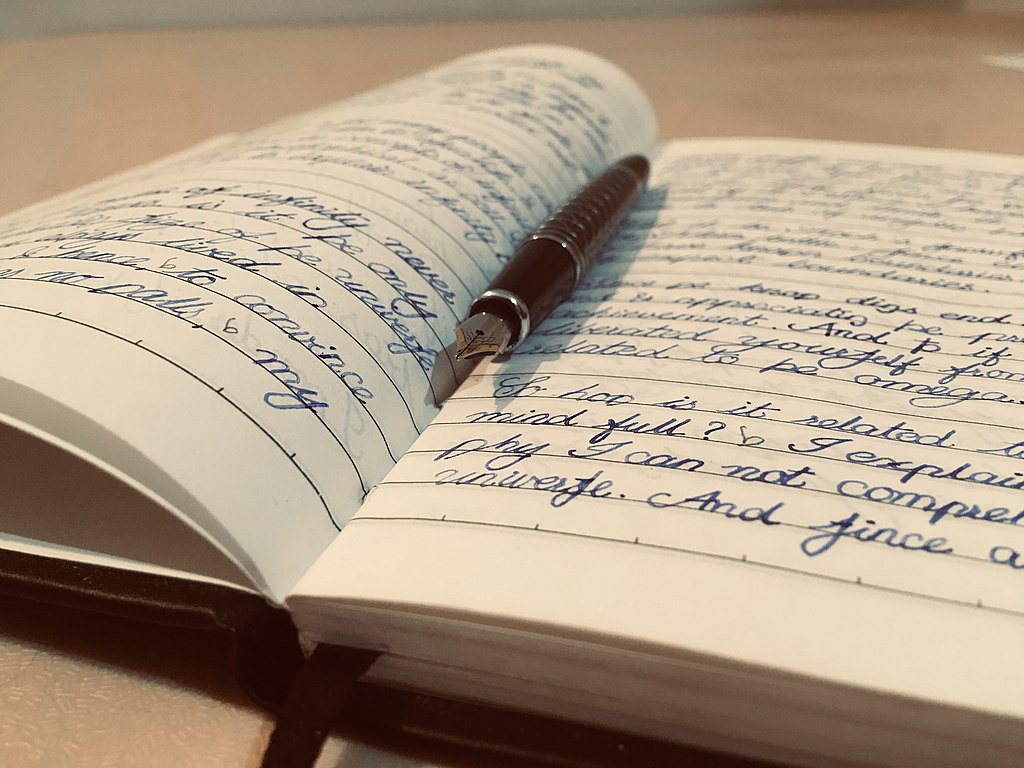
What I would consider the classic journal is much like a diary. It is a written or typed document with a series of dated entries that both records the writer’s experiences and their feelings about those events.
However, the difference between a diary and a journal depends on who you ask.
For some a diary and a journal are synonymous. They are both a daily record of what happened in your life. An article on the University of California, Berkley’s website by Kira M. Newman, titled “How Journaling Can Help You in Hard Times” uses the words diary and journal interchangeably. Newman emphasizes the writer discussing their feelings.
For others, including the Smithsonian Institute’s Archives of American Art, a diary and a journal are distinguished by the amount of reflection. The Smithsonian says that a journal is more reflective than a diary and focuses more on the writer’s feelings than on their activities.
Jeffrey Orrico of Sacred Heart University’s Library cites the Oxford English Dictionary as stating that a journal indicates “a more detailed account than that of a diary.”
Others say a journal is less private than a diary, noting the use of the term in classrooms, where the student expects a teacher to read what they write.
And still others, distinguish between a journal and a diary by the frequency of the entries, noting the expectation for a diary is daily and more varied for journals.
The variations of definitions listed above affirm what I have repeatedly said. Your journal is your journal. You decide what you are going to include and how often you make entries.
The only commonality that I think is generally expected is that you date each entry.
Journaling Idea #30: Folklore, Mythology, Household Tales
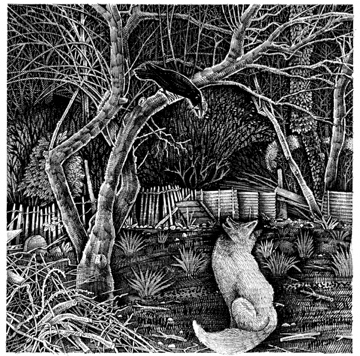
There’s nothing quite as inspiring as a folktale or a myth. Just ask Walt Disney.
Folktales and myths are stories that have been passed down for generations within a community or a country, providing explanations for how or why things came to be; others providing moral lessons. Household tales are similar stories told within a singular family.
A wonderful free source about folktales and mythology was created by D. L. Ashliman, a long retired professor from the University of Pittsburgh.
Folktales and myths can serve as springboards to remembering your own personal stories or to creating new fictional stories.
I followed the link from Ashliman’s site to Bartleby’s collection of Aesop’s Fables and created five prompts in a short time:
- The moral of Aesop’s “The Man and the Serpent” (“Injuries may be forgiven, but not forgotten.” led me to write the prompt: Every scar has a story. Tell the story of one of your scars.
- The “Town Mouse and the Country Mouse” reminded me of the adage “The grass is always greener on the other side of the fence.” Describe a time in your experience when this was false.
- After reading “The Fox and the Crow” with its moral “Do not trust flatterers,” people might ask themselves, am I more of a fox or a crow?
- The moral of Aesop’s “The Lion and the Mouse” is “Little friends may prove great friends.” When has a kind deed been repaid to you?
- “The Sick Lion” leads me to wonder what the insults I have received say about the people who said them.
Be warned: Ashliman’s website is a bit of rabbit hole. Enjoy, but don’t get lost.
Journaling Idea #29: A Reader’s Journal
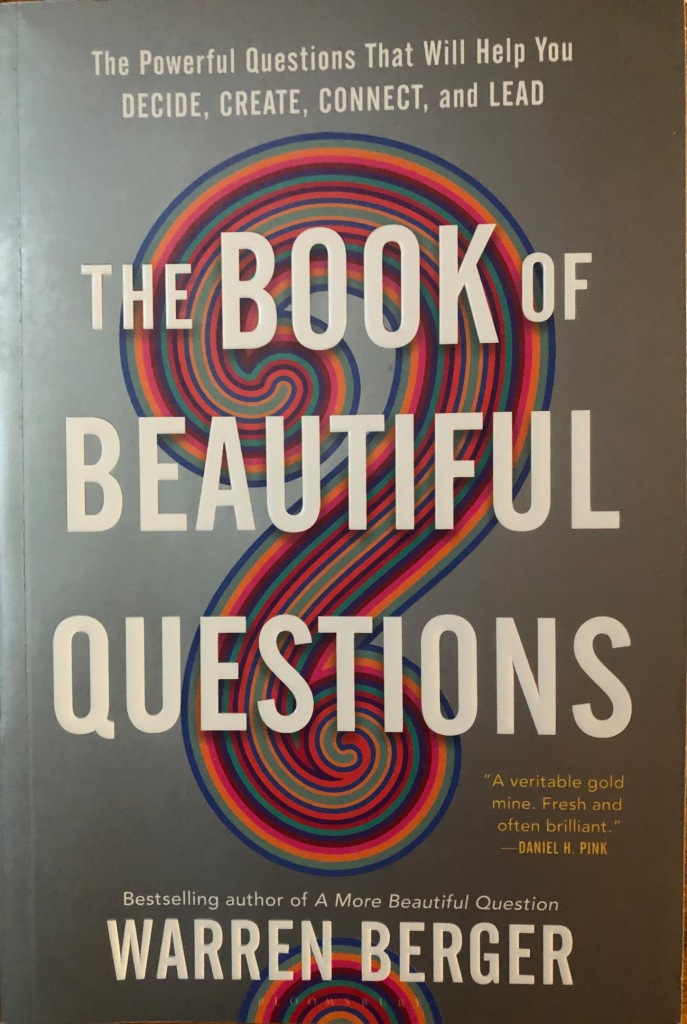
When we read, we are not metaphorically vacuuming up the words from the page; rather, we are making sense of the symbols we encounter by relating them to previous material we have encountered. Reader-response theory leads us to consider that every reader, therefore, has a unique reading of a text based on their personal experiences.
Keeping a journal in relation to your reading, gives you the opportunity to enrich your reading experience.
Before Reading
Writing before reading brings to consciousness your previous knowledge and gives you the chance to record your predictions about what you are going to read . Readers make a surprising number of observations of a text before they read it that set them up to interpret it. We do judge a book by its cover. The packaging of a text (cover design, title, fonts, etc.) give us clues as to the text’s genre. Our expectations about what kind of text we are reading shape what we expect to find.
So, before you start reading, write down what you think the text will be be like:
- Do you think the text is fiction or nonfiction?
- Is it a narrative, an argument, or an explanation?
- Why are you reading this text?
- Who is the author and what do you know about them?
- What kind of text is it?
- How do you expect the structure of the text to go?
- What have you read like this text before?
- What topics and/or themes do you expect to encounter?
Writing before reading prepares you to read. Context and experience will teach you what and how much to write.
I’m excited to read Warren Berger’s The Book of Beautiful Questions. Having read read Berger’s article in Spirit magazine and his first book, A More Beautiful Question, I’m expecting Berger to inform me about the different types and functions of questions. I imagine he will be advocating for the importance of questioning in business, education, and everyday life. I’m hoping to gain more skills in the making and using of questions to share with my students.
David Stone’s prereading entry for Warren Berger’s The Book of Beautiful Questions
While Reading
Take time to pause to write periodically while reading. You can pause at divisions in the text, or when the impulse strikes you. The California Reading Association lists 26 things good readers do. Writing some of those things down can help a reader of any age to become more self-aware of the strategies they use and allow them to be more consciously reflective. I selected the following activities from the CRA list that I think would work well in a journal:
- Summarize.
- Make predictions.
- Take account of what you already know.
- List what is new to you.
- Note what you want to learn.
- Make comparisons.
- Connect what you are reading to your life experience and/or to your vicarious experiences.
- Paraphrase complex sentences to make them personally meaningful.
- Question.
- Make comments in response to what you have read.
- Record whether your predictions were accurate.
In addition to the activities suggested by the CRA, I would add write out quotes that you might use later.
I like how Berger uses questions for the subtitles of his chapters and for the book’s subheadings. His introduction is subtitled “Why Question?” He notes how questioning is where inventive change begins (3), questioning can change our perceptions, expand our vision, make us aware and move us beyond our preconceived preferences, and open up creativity and our range of emotional response (4). Berger introduces how his book is divided into what he sees as the four major uses of questions: decision-making, creativity, connecting with others, and leadership. I found myself concerned in response to the “What can we learn from a four-year-old girl?” section that Berger might spend a lot of this new book restating information that I had read in his first book. Review is good, but I am looking to learn new things.
David Stone’s reading entry written in response to the Introduction of Warren Berger’s The Book of Beautiful Questions
After Reading
Behind every text is an author. Reading could be compared to listening. So when you are done reading a text, it is your turn as the reader to reflect and respond.
Here’s your opportunity to agree, to disagree, to provide further examples, make comparisons, note areas where you think more needs to be written or researched, comment on the quality of what you read or how it was written. You may want to engage your own creativity to a work of fiction and write an alternate ending or a sequel.
Your reader’s journal may be something you keep to yourself, or may be something you share with a family member, friend, book club, class, or colleague.
I enjoy reading my own reader’s journals from thirty years ago. I laugh at how much I have forgotten that I have read and find satisfaction in reconsidering my earlier responses.
If reading is not your thing, many of the same strategies could be used for a viewer’s journal as well.
Journaling Idea #28: Write about the News
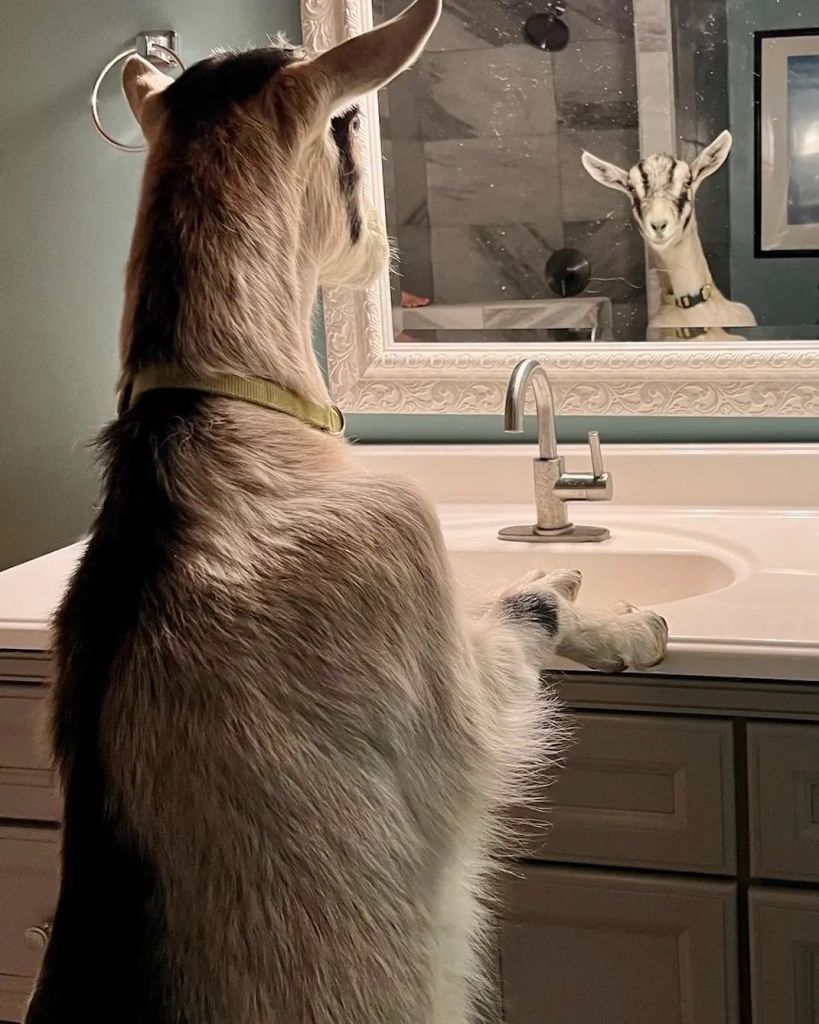
When city newspapers cover an international or national story, they often publish a local news story next to it. The reporter looks for connections between what the wire services are reporting and their local community. In the same manner, a journaler can make use of the day’s news and look for a local connection.
Many people use the local news approach when they write posts for social media. A former student of mine made such a move for a post on Facebook:
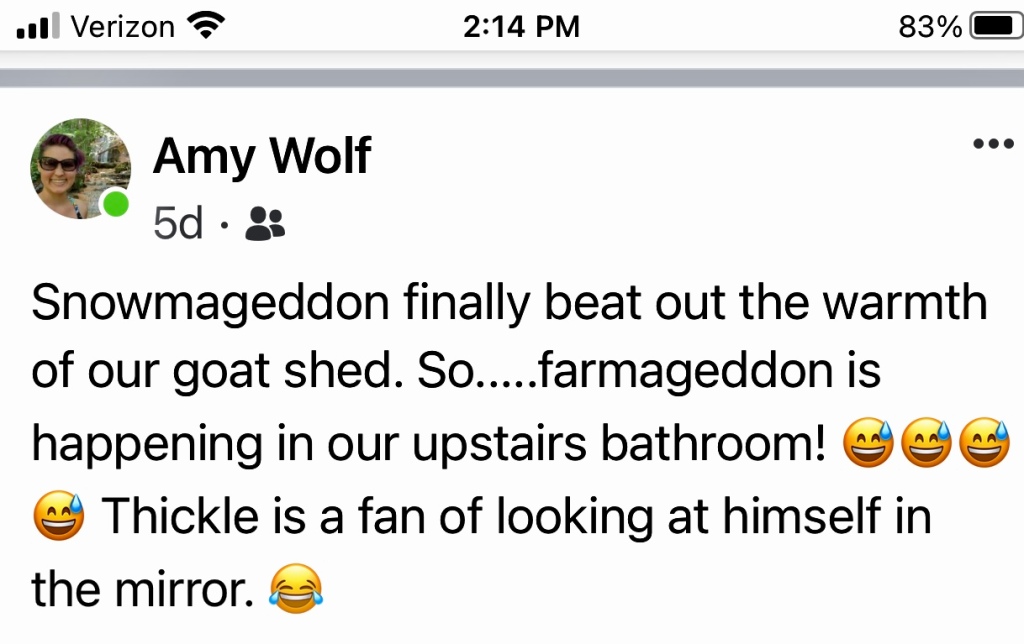
Wolf’s words and photo were quite the hit. Nick Beres, a journalist for News Channel 5, reposted Wolf’s picture of Thickle looking at himself in the mirror and wrote his own clever commentary. Beres’ post received over a thousand comments and nearly four thousand shares.
I love the way Wolf wrote her post. Her pairing of the words “snomageddon” with “farmageddon” is clever. She starts with the larger event and moves to its impact on her life.
Responses to news in a journal can be as short as Wolf’s post or as long as the writer wishes. A journaler can choose to write in prose like Wolf or write in verse. I advocated for poets to write in response to the news in a column titled “Poetry Made Present,” published in The Press Enterprise on September 8, 2014.
Wolf could have easily adapted her response into the form of a septolet. The website Shadow Poetry defines a septolet as “a poem consisting of seven lines containing fourteen words with a break in between the two parts. Both parts deal with the same thought and create a picture.”
Here’s my septolet created from Wolf’s words:
Thickle and Friends
Snowmageddon
beat out
our goat shed’s warmth,
so farmaggedon
happened
in our upstairs
bathroom.
Wolf’s post reminded me of the pet goats named Zebu and Daisy that I purchased for a 4-H project with a friend. Thinking of how Zebu even ate my homework, I replied to Wolf’s post that I hope she had removed the shower curtain and towels from her bathroom.
My humor soon faded, however, as I remembered Zebu and Daisy’s fate.
Blizzard of 2022
Facebook shows
Amy’s goats
in her bathroom.
Mine
froze in
the barn
in ‘83.
I hope you will give writing about the news a try for an occasional entry in your own eclectic journal or in a journal devoted to responses to the news.
